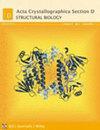Crystal structure and kinetic studies of a tetrameric type II β-carbonic anhydrase from the pathogenic bacterium Vibrio cholerae.
IF 2.2
4区 生物学
Acta Crystallographica Section D: Biological Crystallography
Pub Date : 2015-12-01
DOI:10.1107/S1399004715018635
引用次数: 92
Abstract
Carbonic anhydrase (CA) is a zinc enzyme that catalyzes the reversible conversion of carbon dioxide to bicarbonate (hydrogen carbonate) and a proton. CAs have been extensively investigated owing to their involvement in numerous physiological and pathological processes. Currently, CA inhibitors are widely used as antiglaucoma, anticancer and anti-obesity drugs and for the treatment of neurological disorders. Recently, the potential use of CA inhibitors to fight infections caused by protozoa, fungi and bacteria has emerged as a new research direction. In this article, the cloning and kinetic characterization of the β-CA from Vibrio cholerae (VchCAβ) are reported. The X-ray crystal structure of this new enzyme was solved at 1.9 Å resolution from a crystal that was perfectly merohedrally twinned, revealing a tetrameric type II β-CA with a closed active site in which the zinc is tetrahedrally coordinated to Cys42, Asp44, His98 and Cys101. The substrate bicarbonate was found bound in a noncatalytic binding pocket close to the zinc ion, as reported for a few other β-CAs, such as those from Escherichia coli and Haemophilus influenzae. At pH 8.3, the enzyme showed a significant catalytic activity for the physiological reaction of the hydration of CO2 to bicarbonate and protons, with the following kinetic parameters: a kcat of 3.34 × 10(5) s(-1) and a kcat/Km of 4.1 × 10(7) M(-1) s(-1). The new enzyme, on the other hand, was poorly inhibited by acetazolamide (Ki of 4.5 µM). As this bacterial pathogen encodes at least three CAs, an α-CA, a β-CA and a γ-CA, these enzymes probably play an important role in the life cycle and pathogenicity of Vibrio, and it cannot be excluded that interference with their activity may be exploited therapeutically to obtain antibiotics with a different mechanism of action.霍乱弧菌四聚体ⅱ型β-碳酸酐酶的晶体结构和动力学研究。
碳酸酐酶(CA)是一种锌酶,催化二氧化碳可逆转化为碳酸氢盐(碳酸氢)和质子。由于ca参与了许多生理和病理过程,因此已被广泛研究。目前,CA抑制剂被广泛应用于抗青光眼、抗癌和抗肥胖药物以及神经系统疾病的治疗。近年来,利用CA抑制剂对抗原生动物、真菌和细菌引起的感染已成为一个新的研究方向。本文报道了霍乱弧菌β-CA (VchCAβ)的克隆及其动力学特性。该酶的x射线晶体结构在1.9 Å分辨率下被解析为完美的单面孪晶,显示出具有封闭活性位点的四聚体II型β-CA,其中锌与Cys42、Asp44、His98和Cys101呈四面体配位。底物碳酸氢盐被发现结合在靠近锌离子的非催化结合口袋中,正如报道的其他一些β-CAs,例如来自大肠杆菌和流感嗜血杆菌的β-CAs。在pH 8.3时,该酶对CO2与碳酸氢盐和质子水化的生理反应表现出显著的催化活性,其动力学参数为:kcat为3.34 × 10(5) s(-1), kcat/Km为4.1 × 10(7) M(-1) s(-1)。另一方面,乙酰唑胺(Ki = 4.5µM)对新酶的抑制作用较差。由于该细菌病原体编码至少三种ca, α-CA, β-CA和γ-CA,这些酶可能在弧菌的生命周期和致病性中发挥重要作用,不能排除对其活性的干扰可能用于治疗以获得具有不同作用机制的抗生素。
本文章由计算机程序翻译,如有差异,请以英文原文为准。
求助全文
约1分钟内获得全文
求助全文
来源期刊
自引率
13.60%
发文量
0
审稿时长
3 months
期刊介绍:
Acta Crystallographica Section D welcomes the submission of articles covering any aspect of structural biology, with a particular emphasis on the structures of biological macromolecules or the methods used to determine them.
Reports on new structures of biological importance may address the smallest macromolecules to the largest complex molecular machines. These structures may have been determined using any structural biology technique including crystallography, NMR, cryoEM and/or other techniques. The key criterion is that such articles must present significant new insights into biological, chemical or medical sciences. The inclusion of complementary data that support the conclusions drawn from the structural studies (such as binding studies, mass spectrometry, enzyme assays, or analysis of mutants or other modified forms of biological macromolecule) is encouraged.
Methods articles may include new approaches to any aspect of biological structure determination or structure analysis but will only be accepted where they focus on new methods that are demonstrated to be of general applicability and importance to structural biology. Articles describing particularly difficult problems in structural biology are also welcomed, if the analysis would provide useful insights to others facing similar problems.

 求助内容:
求助内容: 应助结果提醒方式:
应助结果提醒方式:


